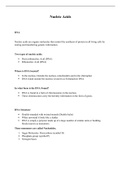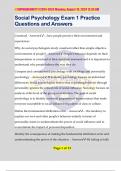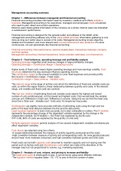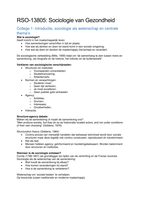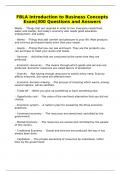Nucleic Acids
DNA
Nucleic acids are organic molecules that control the synthesis of protein in all living cells by
storing and transferring genetic information.
Two types of nucleic acids:
Deoxyribonucleic Acid (DNA)
Ribonucleic Acid (RNA)
Where is DNA located?
In the nucleus, Outside the nucleus, mitochondria and in the chloroplast
DNA found outside the nucleus is known as Extranuclear DNA.
In what form is the DNA Found?
DNA is found in a form of chromosomes in the nucleus.
These chromosomes carry the heredity information in the form of genes.
DNA Structure
Double-stranded with twisted strands (Double-helix)
When unwound it looks like a ladder.
DNA is simply a polymer made up of a large number of similar units or building
blocks known as monomers.
These monomers are called Nucleotides.
1. Sugar Molecules- Deoxyribose (symbol D)
2. Phosphate group (symbol P)
3. Nitrogen bases
, Nitrogenous Bases
DNA has four different types of nitrogenous bases:
1. Adenine
2. Thymine
3. Guanine
4. Cytosine
Nitrogenous bases pair as follows:
Adenine (A) pairs with Thymine (T)
Guanine (G) pair with Cytosine (C)
These Nitrogenous bases are joined together by weak hydrogen bonds, which can be easily
broken down by enzymes.
DNA Profiling
DNA profiling Is the process in which a specific DNA pattern, called profile, is
collected from a person a sample of bodily tissue. During DNA profiling a pattern of
dark bands that is unique to a person is produced.
Every individual on earth has his/her own unique DNA profile, Except for in case of identical
twins with the same DNA profile.
Main Uses for DNA Profiling are:
To help establish the compatibility of tissue type for organ transplant
To identify diseases
To gain proof of paternity
DNA
Nucleic acids are organic molecules that control the synthesis of protein in all living cells by
storing and transferring genetic information.
Two types of nucleic acids:
Deoxyribonucleic Acid (DNA)
Ribonucleic Acid (RNA)
Where is DNA located?
In the nucleus, Outside the nucleus, mitochondria and in the chloroplast
DNA found outside the nucleus is known as Extranuclear DNA.
In what form is the DNA Found?
DNA is found in a form of chromosomes in the nucleus.
These chromosomes carry the heredity information in the form of genes.
DNA Structure
Double-stranded with twisted strands (Double-helix)
When unwound it looks like a ladder.
DNA is simply a polymer made up of a large number of similar units or building
blocks known as monomers.
These monomers are called Nucleotides.
1. Sugar Molecules- Deoxyribose (symbol D)
2. Phosphate group (symbol P)
3. Nitrogen bases
, Nitrogenous Bases
DNA has four different types of nitrogenous bases:
1. Adenine
2. Thymine
3. Guanine
4. Cytosine
Nitrogenous bases pair as follows:
Adenine (A) pairs with Thymine (T)
Guanine (G) pair with Cytosine (C)
These Nitrogenous bases are joined together by weak hydrogen bonds, which can be easily
broken down by enzymes.
DNA Profiling
DNA profiling Is the process in which a specific DNA pattern, called profile, is
collected from a person a sample of bodily tissue. During DNA profiling a pattern of
dark bands that is unique to a person is produced.
Every individual on earth has his/her own unique DNA profile, Except for in case of identical
twins with the same DNA profile.
Main Uses for DNA Profiling are:
To help establish the compatibility of tissue type for organ transplant
To identify diseases
To gain proof of paternity

